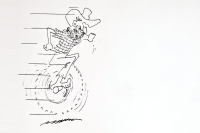The time is ripe for garden planning
January is a time for new beginnings; nowhere is that more true than in the garden.
A difficult task for newcomers to Western North Carolina who want to garden, or for first-timers to gardening, is an absence of good information on what vegetables to begin planting when.
The N.C. Cooperative Extension Service has when-to-begin lists on its website and at local offices. Frankly, though useful as a baseline, the state’s lists aren’t in my experience particularly helpful. That’s because the agency isn’t daring in its recommended growing practices, doesn’t factor in the use of protective covering and compiled the lists with traditional growers in mind.
Nothing wrong with any of those things, but traditional WNC growers were and are more interested in summer produce: corn, tomatoes, okra and squash. There’s much more out there than that. And much more fun to be had during our lengthy growing season than in just planting traditional garden mainstays.
If you have a greenhouse, an indoor growlight setup or a sunny place near the window, you can get started with this year’s garden now. During my stint farming in Bryson City I compiled a seed-starting list. I thought I’d share the first few months of the year in this space, and perhaps the remainder of the list in upcoming columns. I do need to take the time to tweak the list based on later farming journals I kept. Some of the Asian vegetables I became interested in aren’t well represented.
A few caveats are in order. Bear in mind that I was growing for farmers markets, and that I was farming for a financial living. This meant I was aggressive with my start dates. I wanted to be the first into market, if possible, with various vegetables. Factor in that I was farming at about 2,000 feet in elevation on a southerly slope. The average last frost date in that location is May 10. If you live in higher elevations, adjust my starting dates by roughly two (or more) weeks.
Related Items
Mid January
• First round cabbage, broccoli to plant later under row cover.
Last week January
• Second round cabbage, broccoli (can continue planting in greenhouse through February as needed).
• Peppers (can continue into February as needed, helps germination to start on a heating mat. Must be transplanted into continually bigger containers).
• Artichokes (you can “trick” artichokes into growing in WNC by introducing the plants to various temperatures in their first weeks of life. Perhaps I’ll write on that topic more fully at a later date).
First week February
• Leeks.
• Head lettuces.
• Chives, thyme, other herbs (continue planting through February, March as needed).
Second or third week February
• Parsley.
In garden toward end of February, first week of March weather permitting, (be prepared to cover transplants when temperatures threaten to drop lower than 20 degrees):
• Transplant lettuce, broccoli and cabbage into garden.
• Direct seed leaf lettuce, snow peas, English peas, carrots, boc choi, onion sets, spinach, radishes, beets (keep succession growing through late winter into spring).
First week March
• Start tomatoes in greenhouse (Must be transplanted into continually bigger containers in greenhouse).
• Start eggplant.
Second week March
• Plant potatoes in garden.
• Direct seed kohlrabi in the garden.
• In greenhouse, marigolds, zinnias, ageratum, if you enjoy cutting flowers.
April
Continue transplanting in greenhouse. Direct seed in garden:
• Beets, onion sets (for green onions), radishes.
• Direct seed cilantro, pole or bush beans, first planting of soybeans, and sweet corn when the soil warm (old-timers here in the mountains planted early corn when the dogwood blooms).
Early to mid May
• Plant leek transplants into garden.
• Direct seed okra into garden.
• Direct seed basil, can plant later, too, to have with ripe tomatoes.
Succession soybeans, beets, onion sets, radishes.
• Direct seed summer squash, cucumbers, cantaloupe, watermelon, pumpkin.
• Transplant tomatoes, eggplants and peppers as weather permits.
• Direct seed red noodle bean (an Asia bean I’m particularly fond of).
Mid to late May
• Direct seed winter squash, spaghetti and butternut squashes.
• Under row cover, grow succession plantings of summer ‘lettuce’ mix: mizuna, kale, collards, tatsoi, red giant mustard, arugula. Use as cut-and-come again, harvest immature for raw salads. Replant short row every two weeks or so for summer use.
• Plant sweet potato slips.
• Plant chard, if haven’t already, also Malabar spinach, dill.
(Quintin Ellison can be reached at This email address is being protected from spambots. You need JavaScript enabled to view it.)









